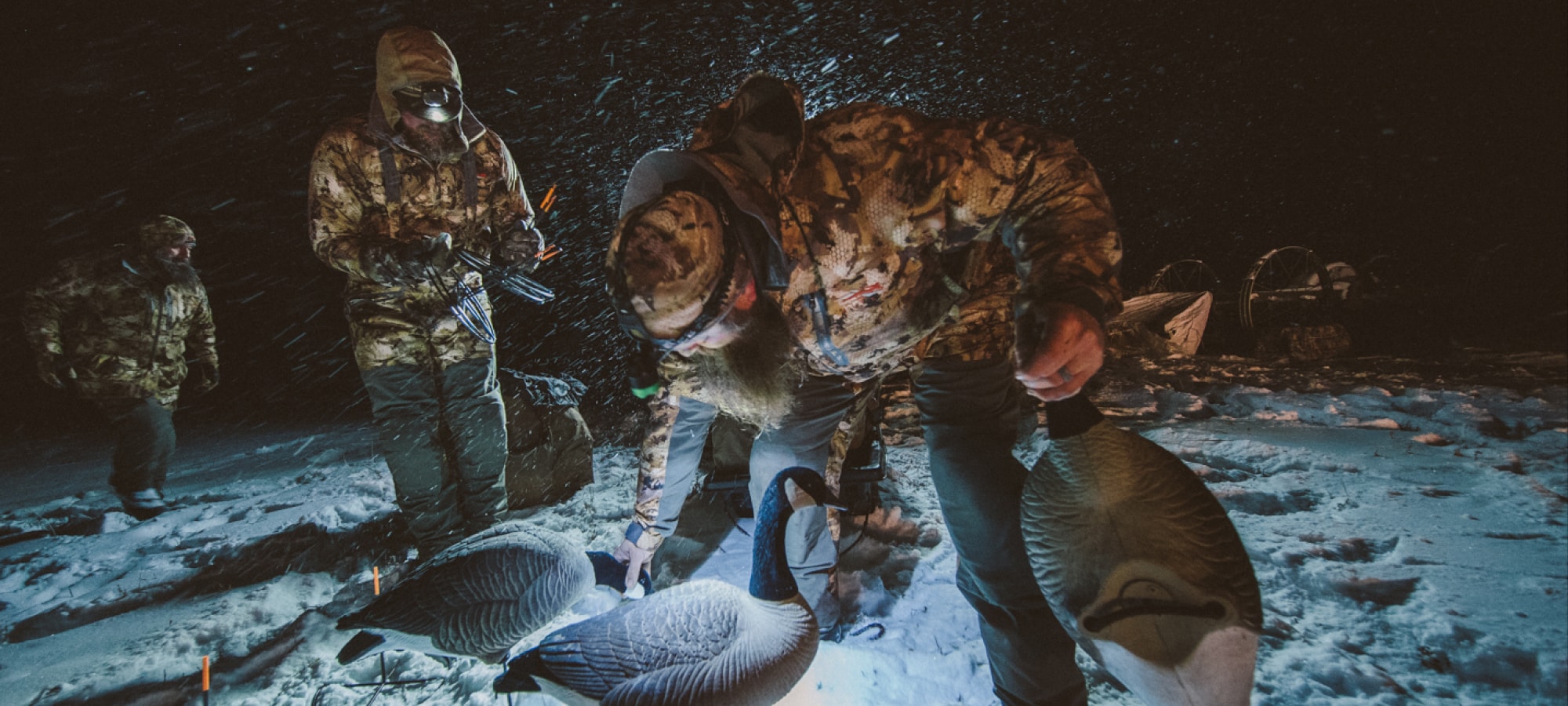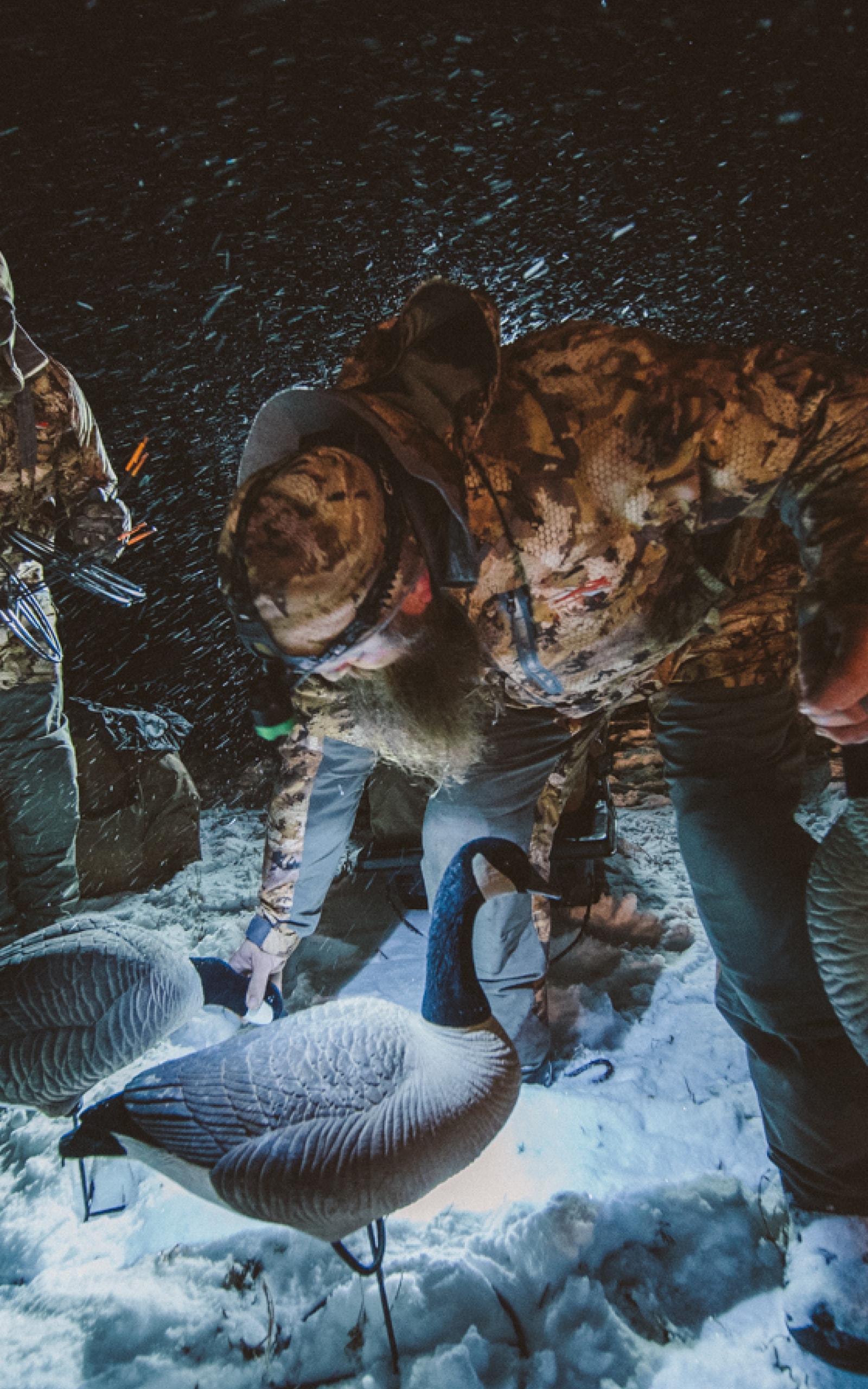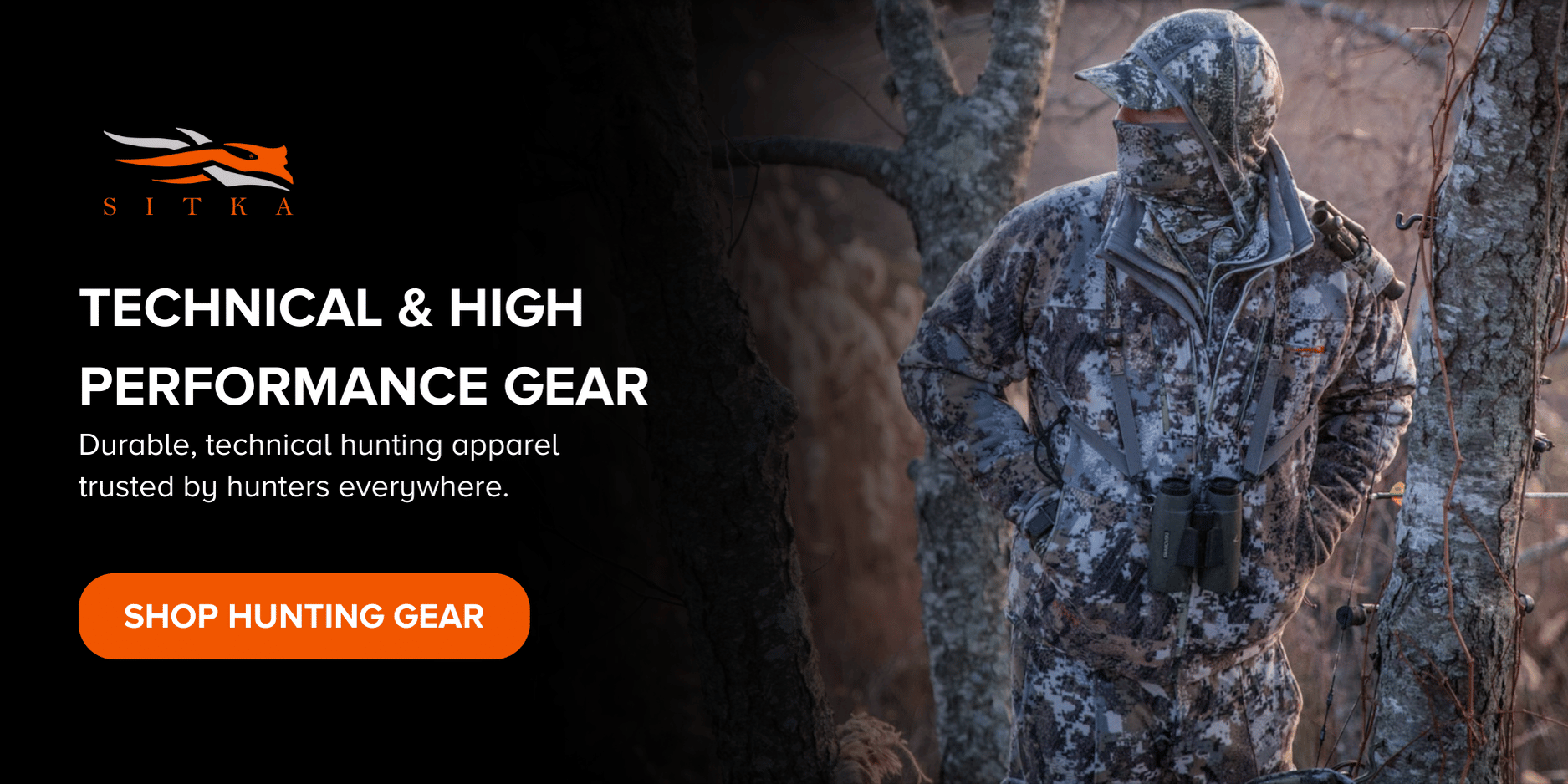10.22.2024
What Are the Warmest Hunting Clothes for Cold Weather?
Hunters face a range of challenges when braving cold weather, with the most significant risks being hypothermia and frostbite. Understanding these dangers and the importance of selecting appropriate hunting clothing can make the difference between a successful hunt and a hazardous experience.
Hypothermia and frostbite are real risks, but another real-world risk for hunters before those things set in is just being too cold to maintain focus. Having to leave the treestand or blind early, or pack out of the mountains when the weather sets in, because you’re too cold can really blow up a hunt, especially when you’ve spent all year scouting, or used up vacation days, or have drawn that tag you’ve been putting in for for years.
Understanding the Risks of Cold Weather Hunting
Hypothermia Awareness
When the body's core temperature drops below normal, hypothermia sets in, causing shivering, confusion, and exhaustion. Hunters face a higher risk due to prolonged stillness in very cold temperatures, which reduces body heat. Hypothermia can be extremely dangerous, even life threatening. It’s important to wear the proper clothing when cold weather hunting.
Frostbite Prevention
Frostbite freezes skin and tissues, mainly in extremities like fingers and toes. Early signs are cold skin and numbness, potentially leading to permanent damage or amputation if severe. Hunters face the challenge of enduring harsh, cold environments for extended periods, making frostbite prevention essential. To prevent frostbite while hunting, several strategies can be employed:
Layering System: Utilize a moisture-wicking base layer, an insulating layer, and a waterproof outer layer.
Headgear: Wear insulated hats to prevent heat loss.
Gloves and Mittens: Opt for insulated and waterproof hunting gloves options.
Footwear: Ensure insulated, waterproof boots with proper fit.
Socks: Choose wool or synthetic socks over cotton.
Manage moisture by avoiding cotton and using waterproof gear.
Be aware of wind chill and take breaks in severe weather.
Stay active to generate body heat.
Use face protection and hand/foot warmers.
Stay hydrated and consume high-energy foods.
Avoid overly tight clothing and footwear
Recognize Early Signs of Frostbite
Preventing frostbite while hunting involves wearing suitable clothing, staying dry, being weather-aware, keeping active, and maintaining proper nutrition. These precautions help minimize the risk of frostbite, ensuring a safer and more enjoyable hunting experience.
Essential Features of Warm Hunting Clothes
An adequate layering system can help keep you comfortable and prevent hypothermia and frostbite. It all comes down to these three important layers:
Base Layer: Moisture-wicking fabrics like wool or synthetics keep skin dry.
Insulating Layer: Fleece or down materials trap heat without bulk.
Outer Layer: Windproof and waterproof shells like Gore-Tex shield against elements.
Head and Limbs: Protect heat loss areas with insulated hats, gloves, and socks to prevent frostbite.
Here are some additional considerations:
Footwear: Insulated, waterproof boots are essential to avoid discomfort and reduce the risk of hypothermia and frostbite.
Accessories: Hand warmers, hunting neck gaiters, and balaclavas offer added warmth and comfort.
Avoid Cotton: Choose wool or synthetics over cotton to prevent heat loss and hypothermia risk.
Proper Fit: Clothes should be snug but not tight to prevent frostbite. Loose clothing lets heat escape, while tight wear hinders blood flow.
A puffy jacket is a crucial item in any wardrobe, regardless of the time of year. Whether you choose down or synthetic insulation, either captures warmth emitted by the body, helping conserve energy and allowing you to stay focused on our tasks. Wind is a constant variable that can significantly impact your outdoor experience. It has the power to transform a pleasant day outdoors into a tiring and challenging ordeal, draining your body heat and composure if you're not ready for it. The innovative GORE® WINDSTOPPER® technology effectively blocks the chilling effects of wind and can be integrated into various fabrics that balance breathability, water resistance, warmth, comfort, and lightweight portability. This technology provides hunters with the ideal solution to combat windy conditions based on their surroundings and activities.
Material Choices
To ensure hunters stay warm and dry in chilly conditions, it is essential to choose the right materials for insulation and moisture-wicking properties. Below are some top choices for these purposes:
Moisture Management Fabrics: Fabrics that manage moisture are created to pull sweat away from the skin, maintaining hunters' dryness and comfort. The most efficient moisture-wicking materials consist of:
Merino Wool: Merino wool is a natural fiber renowned for its exceptional ability to wick moisture away from the skin while offering insulation. This material is gentle, breathable, and naturally resists odors. Commonly used in the warmest hunting clothes, Merino wool hunting clothes can help regulate body temperature, ensuring hunters are not only warm in the cold but also cool in the heat.
Synthetic Fabrics (Polyester, Nylon): Synthetic fabrics such as polyester and nylon are specially designed to draw moisture away from the body. These fabrics are lightweight, quick to dry, and long-lasting. They are commonly utilized in hunting base layers and active wear because of their effectiveness in managing sweat.
Layering for Optimal Warmth
Insulating materials play a crucial role in preserving body warmth and ensuring hunters stay cozy in chilly environments. Various types of insulating materials are available to help with this, including:
Down
Down is crafted from the soft feathers of ducks or geese, serving as a highly efficient natural insulator. Down boasts an outstanding warmth-to-weight ratio, can be compressed easily, and lasts a long time with proper maintenance. Down insulation is particularly suitable for extremely cold and arid conditions.
Synthetic Insulation (Primaloft, Thinsulate)
Synthetic insulation is produced from artificial fibers that imitate the insulating properties of down. It maintains its insulating capabilities even when wet, dries rapidly, and is hypoallergenic. Synthetic insulation is a smart option for damp conditions where down may lose its insulating effectiveness.
Fleece
Fleece, a synthetic fabric made from polyester, offers good insulation and breathability. Itis lightweight, dries quickly, and retains heat even when damp. Fleece is commonly utilized in intermediate layers to add warmth without bulk.
Wool
Wool, a natural fiber, delivers exceptional insulation and moisture-wicking properties. It preserves warmth even when wet, allows for breathability, and possesses natural odor-resistant qualities. Wool is sturdy and performs well across various temperatures.
Enhancing Warmth and Dryness
To enhance warmth and keep dry, hunters can employ a layering approach that blends moisture-wicking and insulating materials:
Base Layer: Opt for a moisture-wicking material such as merino wool, polyester, or polypropylene to maintain dry skin.
Mid Layer: Utilize an insulating material like fleece, wool, or synthetic insulation to retain body heat.
Outer Layer: Choose a waterproof and windproof shell to shield against the elements while enabling moisture to escape from inner layers.
SITKA Gear’s Solutions for Cold Weather
High-Performance Base Layers
The base layer forms the foundation of any clothing system. This layer is designed to regulate body temperature throughout the year, regardless of the season or weather conditions. It can be worn alone as a shirt in hot conditions and layered over when temperatures drop. By efficiently wicking away moisture, the base layer ensures comfort during any activity or weather condition. The Core Merino 330 Hoodie is designed to keep you warm and focused in the coldest weather and more extreme hunting conditions, while the Core Lightweight Hoodie is the perfect choice for early season sits in the treestand or chasing bugling bulls up the mountain. H3: Insulated Outerwear The Incinerator Aerolite System is SITKA’s warmest whitetail hunting outerwear, crafted with waterproof and breathable GORE-TEX material. It is specially created to ensure your comfort and preparedness in any situation. Tailored for late-season waterfowl hunting in freezing temperatures, strong winds, and heavy snow or rain, the Boreal Aerolite System provides exceptional warmth and insulation. The Blizzard Aerolite System is designed as our most insulated GORE-TEX jacket for big game hunting, this waterproof and breathable shell ensures warmth during harsh late-season weather conditions.
Choose SITKA Gear for Superior Cold Weather Protection
High-quality, well-designed hunting clothing is essential for safety and comfort during cold weather conditions, especially for individuals spending extended periods outdoors while waiting for game. Apart from enhancing the hunting experience, proper hunting gear provides protection against severe weather risks like hypothermia and frostbite. Additionally, our women's hunting gear offers a tailored fit and specialized features to ensure maximum warmth and comfort, supporting female hunters in challenging environments.
Advantages of Quality Hunting Apparel
Effective Insulation: High-quality apparel utilizes advanced insulating materials such as down, synthetic insulation, and fleece, which efficiently retain body heat even in extremely cold climates.
Moisture Management: Quality hunting clothes feature moisture-wicking fabrics like merino wool and synthetic fibers to draw sweat away from the skin, keeping hunters dry and avoiding the chilling effect of damp clothing.
Layering System: Designed for versatility, quality hunting apparel can be layered to adapt to changing weather and activity levels. Ideal layering includes a moisture-wicking base layer, insulating mid-layer, and waterproof outer layer.
Durability and Comfort: Durable materials and ergonomic designs in high-quality hunting attire ensure longevity and freedom of movement, crucial for a successful hunt.
Protection Against Elements: Advanced outer layers made from materials like GORE-TEX shield hunters from wind, rain, and snow, maintaining body heat and preventing exposure-related health issues.
Practical Considerations
For outdoor enthusiasts, reliable gear significantly improves the outdoor experience. Well-chosen hunting apparel allows focus on enjoyment without discomfort or cold-related risks. Investing in high-quality hunting apparel guarantees warmth, dryness, and comfort, enriching the overall hunting experience and ensuring safety. When exploring the wild, it's crucial to ensure your hunting gear meets your needs. For backcountry hunters, the ideal clothing system should be adaptable, lightweight, and able to keep you cozy and dry. The unpredictable mountain weather and distant hunting spots can be unforgiving to those who are ill-prepared. Whether you find yourself in a desert, coastal forests, or high-altitude areas, your clothing system needs to deliver top performance.
A well-constructed technical clothing system will efficiently handle moisture, dry rapidly, and help regulate your body temperature, allowing you to stay focused. Simply layering clothing without a plan won't cut it. Technical apparel should work together seamlessly, using various fabrics, designs, weights, and fits to create a system that feels natural to the wearer. Each layer in a SITKA clothing system plays a specific role.
To construct your perfect hunting concealment system, check out the System Builder to make sure you have the base layers, mid-layers, and outwear for your next adventure.
Sources
Brooks, Brad. n.d. “A Backcountry Hunters Layering Guide–Part 1-the Basics | Argalioutdoors.com.” Argalioutdoors.com. Accessed August 5, 2024. https://argalioutdoors.com/advice/backcountry-hunters-layering-guide-part-1-basics.
Cohen, Ava. 2024. “Top 7 Trends in Hunting Apparel.” Verified Marketing Reports. June 2024. https://www.verifiedmarketreports.com/blog/top-7-trends-in-hunting-apparel/.


